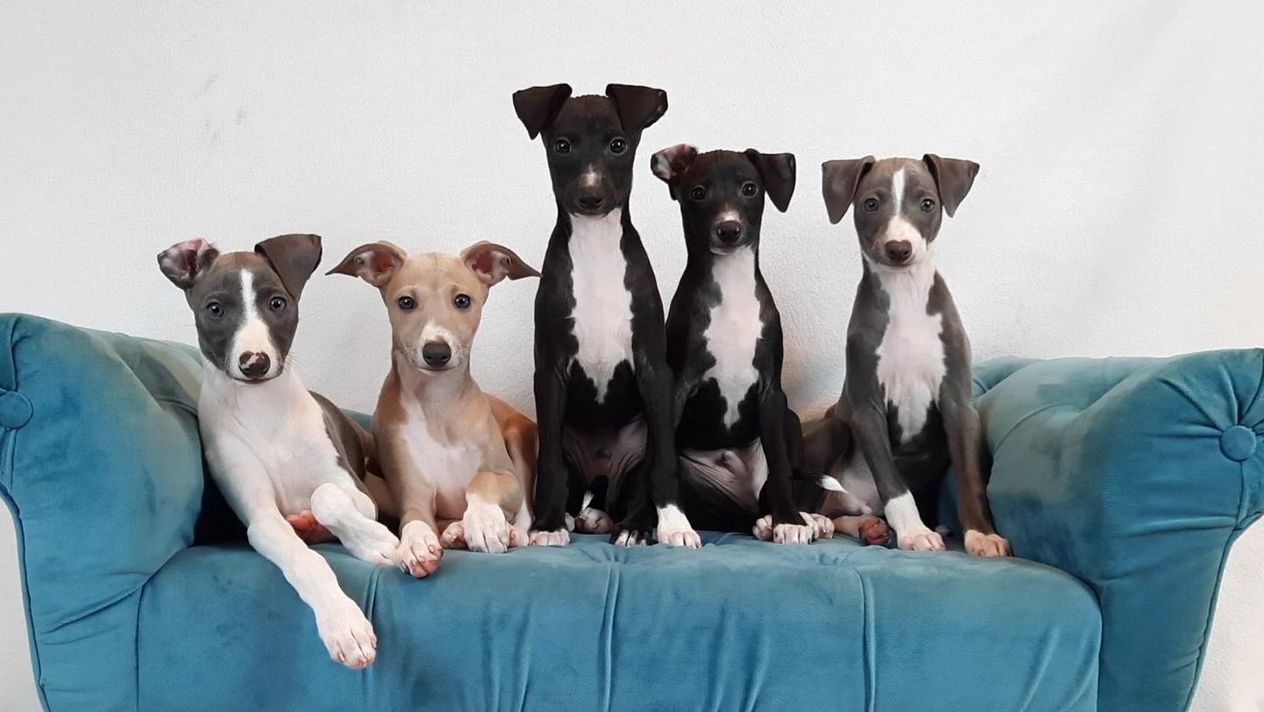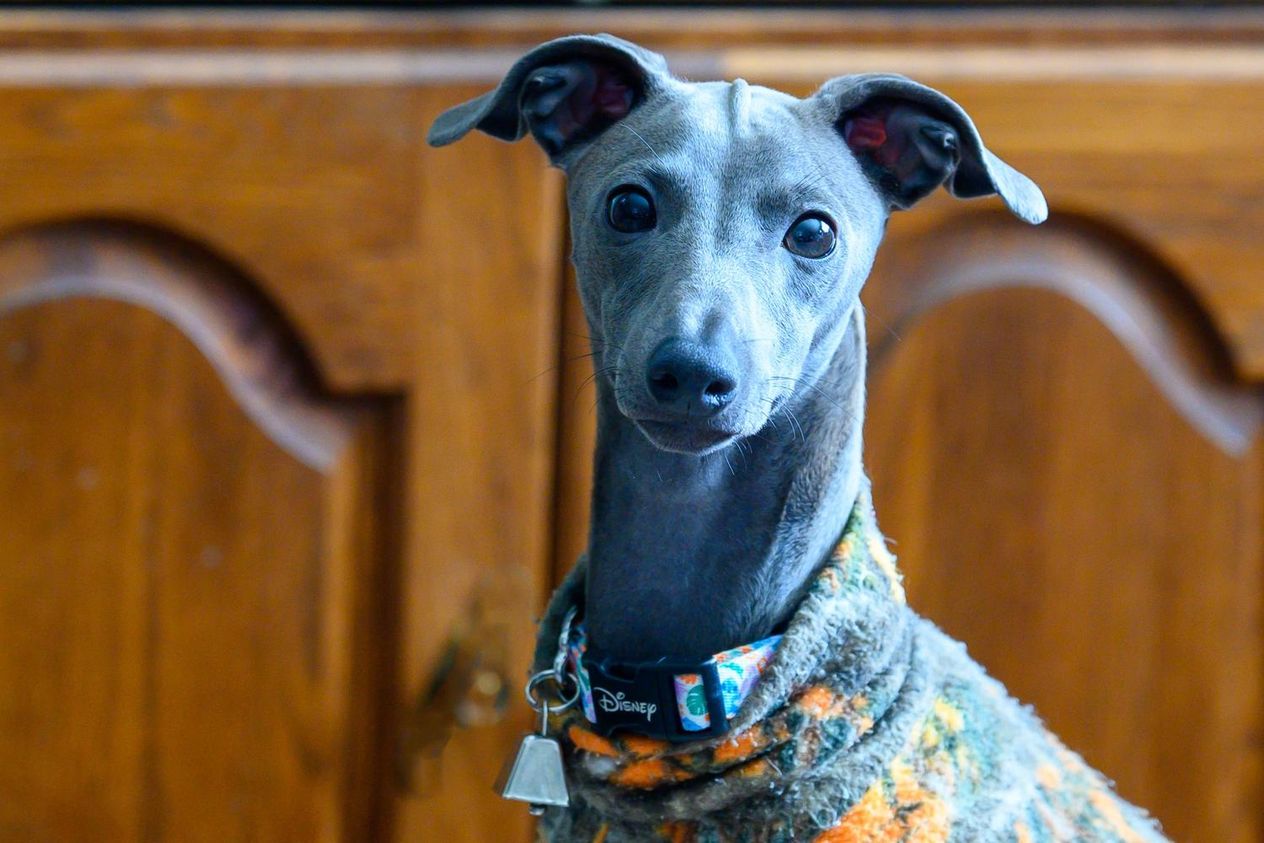Get to know
Italian Greyhounds

Veterinarian reviewed
The epitome in elegance and grace, the Italian Greyhound is a Greyhound in miniature, with sleek lines, but with a much more dainty prance to its gait.
Browse available puppies
Connect with reputable breeders to find the dog of your dreams
At a glance
Low Energy
Energy level
2/5
Minimal Maintenance
Grooming
1/5
Small
Size
Gentle, reserved, can be timid
Temperament
14-15 years
Lifespan
Average Trainability
Training
3/5
Low Vocality
Barking
2/5
At a glance
Energy level
Low Energy
Grooming
Minimal Maintenance
Size
Small
Temperament
Gentle, reserved, can be timid
Lifespan
14-15 years
Training
Average Trainability
Barking
Low Vocality
Why people love the breed
People love IGs for their elegance, gentleness, and love of laps.
Appearance
The Italian Greyhound is a Greyhound in miniature, with some differences.
Grooming
The IG is one of the easiest of all breeds to groom. Its teeth do need particular care, however.
Raindance Italian Greyhounds
Breed temperament and characteristics
The IG is exceedingly gentle but can be timid.
Exercise
IGs are far from hyperactive but they do need to exercise every day.
Alura Italian Greyhounds
Training
IGs are very sensitive and will wilt with force training. They respond to treats and praise very well though.
Diet and nutrition
IGs are naturally slender dogs, and a small difference in weight can make a big difference in appearance.
Macabre Italian Greyhounds
Health issues
IGs are extremely healthy but are at increased risk for broken legs and dental disease, as well as some eye problems.
Lifespan: 14 to 15 years.
Orthopedic conditions
Such as hip dysplasia, Legg-Calve-Perthes disease, patellar luxation and leg fractures are reported in IGs.
Eye conditions
IGs are impacted by several eye conditions including vitreous degeneration, progressive retinal atrophy, glaucoma and cataracts.
Dental disease
This is seen at a higher rate than in larger breeds.
Cryptorchidism
In which one or both testicles fail to descend into the scrotum, is reported at a higher prevalence in IG males.
Color dilution alopecia
In which hair is lost and the skin may become itchy, is seen in some blue IGs.
History
Until the last century, the IG has always been a luxury dog associated with royalty and the upper crust.
About the author
Canine specialist, Caroline Coile, Ph.D., is the author of 34 dog books, including the top-selling Barron's Encyclopedia of Dog Breeds. She’s written thousands of magazine and web articles about dogs. She specializes in canine science, health, breeds and competitions. Caroline has won 20 national dog-writing awards, and was a 2015 Inductee into the Dog Writers Association of America Hall of Fame.
Veterinarian reviewed
Dr. Nate Ritter, DVM is the Veterinary Medical Director at Good Dog. He earned his Bachelor of Science in Biology from Lafayette College and his Doctor of Veterinary Medicine degree from Virginia-Maryland College of Veterinary Medicine. He is a member of the American Veterinary Medical Association, New York State Veterinary Medical Society, the Veterinary Medical Association of New York City, and the Society for Theriogenology. Additionally, he is a USDA-accredited veterinarian.
Breed Scorecard
Characteristics and temperament
Affectionate with family
5
Watchdog level
2
Playfulness
3
Adaptability
2
Social needs
4
Temperament
Gentle, reserved, can be timid
Intelligence
3
Good with other dogs
5
Good with cats or other pets
5
Friendly with strangers
2
Good as a service dog
1
Good for apartments
5
Barking level
2
Appearance
Height
13-15"
Size
Small
Colors
Black, Blue, Black and tan, Cream, Fawn, Red, Sable, Seal, Blue fawn, Red fawn, White and black, White and fawn, White and red, White and sable, White and blue, White and red fawn, White and seal, White and blue fawn, Blue and tan, Brindle, Chocolate, White
Coat texture
Soft, sleek
Coat length
Short, close
Training
Trainability
3
Exercise
Exercise needs
2
Exercise time
One half to one hour daily
Mental exercise needs
2
Favorite activities
Running
Grooming
Grooming needs
1
Brushing frequency
Monthly
Needs professional grooming?
No
Drooling level
1
Health issues
Orthopedic conditions
Eye conditions
Dental disease
Cryptorchidism
Color dilution alopecia
Other
Bred for
Companionship
Country of origin
Italy
Popularity level
3
FAQs
On Good Dog, you can search for Italian Greyhound puppies or dogs in rescues and shelters. Adopting an Italian Greyhound from a shelter or rescue is generally less expensive than buying a puppy from a breeder with ethical practices. Across the United States, there are dedicated rescues that specialize in specific breeds and may even help transport an Italian Greyhound dog to you from another part of the country. Although it can be more cost-effective, adopting the exact breed you're looking for is typically more difficult than working with a responsible breeder. Learn more about adopting a dog from a shelter or rescue.
Yes, if you like a dog that wants to be in your lap all the time.
Pros: They are easy to care for, gentle, and love to cuddle. Cons: They can be delicate, timid, and hard to house train.
Yes, but like any dog, not for long periods of time and may benefit from the company of another IG or even a cat.
Prices for Italian Greyhound puppies for sale vary by breeder and individual puppy. On Good Dog today, Italian Greyhound puppies are typically around $2,750. Because all breeding programs are different, you may find dogs for sale outside that price range.



